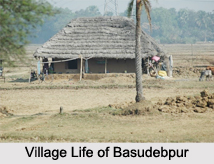 Basudebpur is the census municipality town in Bhadrak District of Odisha.
Basudebpur is the census municipality town in Bhadrak District of Odisha.
Location of Basudebpur
Basudebpur is located at 21.14 degree North to 86.74 degree East. It has an average elevation of 3 metres (9 feet) from the sea level.
Administration of Basudebpur
The administration of Basudebpur is settled in town of Bhadrak of Bhadrak District of Odisha. On the 1st of April 1993 this district was formed from the Balasore District and became a detached entity. The administration of Basudebpur is governed by the current MLA from Basudevpur Assembly Constituency Bijoyshree Routray of BJD, who won the seat in State elections of 2009 and also in 2000 and 2004 and earlier representing JD in 1995 and in 1990. Other previous MLAs from this seat were Madhu Sadan Panigrahi of INC(I) in 1985, Jagabandhu Das of INC(I) in 1980, Nilmoni Routray of JNP in 1977.
Geography of Basudebpur
Basudebpur spreads over an area of 2,677 square kilometres. Salandi River passes along this town.
Demography of Basudebpur
Basudevpur had a population of 219,108. The males constitute 52% of the population and females 48%.
Education of Basudebpur
Basudevpur has an average literacy rate of 60%, higher than the national average of 59.5%; with 60% of the males and 40% of females literate. 14% of the population is under 6 years of age. Basudebpur has many colleges and educational institutions. Atal Bihari College is the premier college located in Basudebpur for higher education. Trupti Women`s College is established in 2000 for educational upliftment of women in Basudevpur. There are two important high schools located in Basudebpur. These are known as Atal Bihari High School and Government Girls High School Basudebpur for higher schooling of Basudevpur subdivision.
Culture of Basudebpur
Basudebpur as it is present in Bhadrak, the people here are Hindus and follows Shakta sects. Here Kali puja and Durga Puja are popular than entire Odisha. The dialect commonly spoken by the people is Oriya language, though a few people speak Urdu language, Santhali language, and Bengali language.
Tourism in Basudebpur
Basudevpur in Bhadrak is located 159 km away from the state capital, Bhubaneswar, and it is well known for the Bhadrakali Temple.
Related Articles
Cities of Orissa
Odisha
Bhadrak District
Bhubaneshwar



















